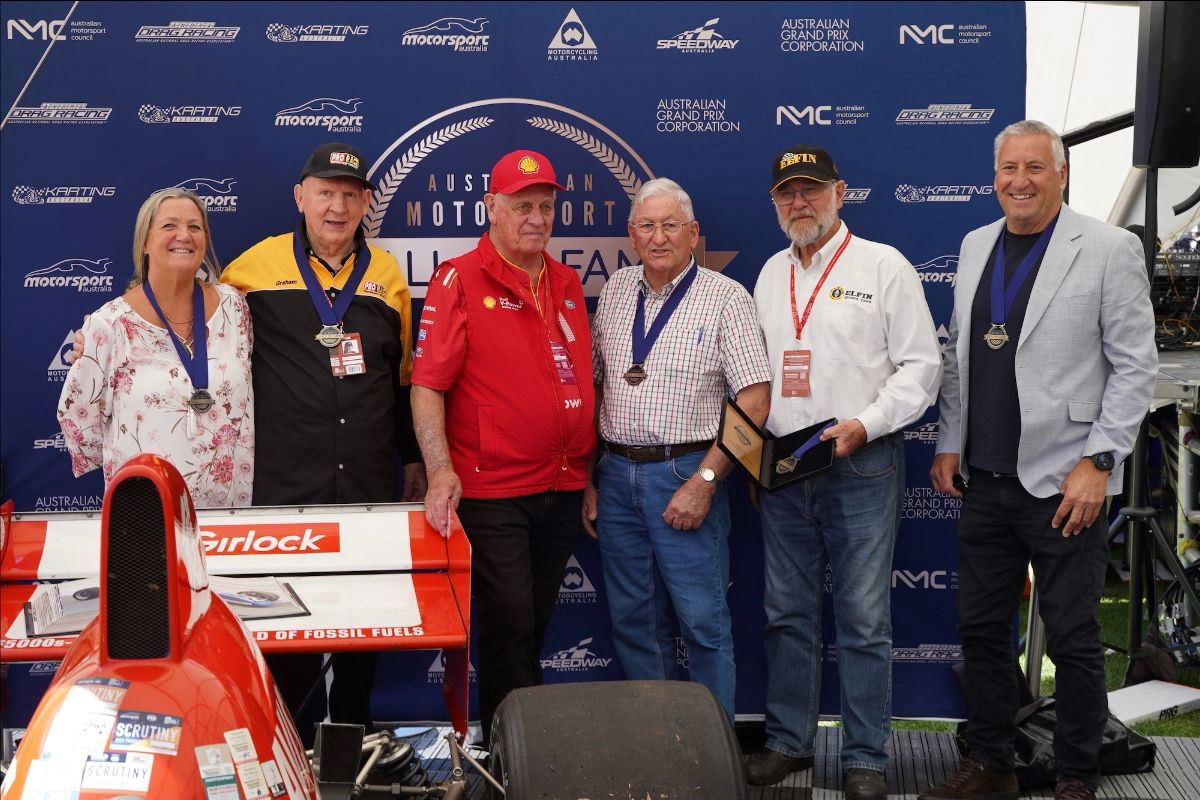

Held on the Tech stage at the Australian Formula One Grand Prix, the ceremony brought inductee number over 124 years to 93.
Johnson who holds an Order of Australia (AM) is also a Hall of Fame member, was made a lifetime Motorsport Australia Member of Honour.
Heading this year’s list is the late Garrie Cooper. He was Australia’s most successful domestic race car constructor. He was Australian Sports Car Champion, 1.5 litre (F2) Champion and winner of the 1968 Singapore Grand Prix, all in his designed and made cars.
He was the driving force behind Elfin sports and racing cars, winners of 29 Australian and International titles. His first car, the Streamliner was so successful that 21 followed. He was at the forefront of Formula Junior in 1961.
Cooper won the 1975 Australian Sports Car Championship in his radical MS7, a car that easily converted a Formula 5000 open wheeler. The MR9 was the only ground effects F5000 to race. He was presented with the Advance Australia Award for his contribution to the South Australian economy.
Several of the Elfin racing cars he built were on display in the Heritage paddock and two of them were brought to the ceremony. Before his passing at age 46, he constructed 248 cars. Accepting the accolade on his behalf was Elfin racing car ambassador, Bill Hemming.
Craig Dack is a five-time national Motocross champion and four-times Mr MX and seen by many as Australian Motocross’ first superstar as the sport came to television. His brand name, the Dack Attack, matched his riding style and his personality.
Dack raced for Australia seven times in the World Motocross of Nations with a best result of fourth in 1988. Injury forced his retirement from active competition, after which he became owner and manager of Craig Dack Racing Yamaha, a motocross team responsible for the discovery of Chad Reed.
Bill Barrows OAM was twice Speedway’s Sportsman of the Year and has been an active and successful competitor, promoter, administrator and volunteer. He was one of the instigators of World Series Sprint Car racing in Australia, helped build South Australia’s Borderline Speedway and secured a round of the Australian championship.
He was second in the Australian Sprint Car Championships, won four state sprint car titles and the 1986 President’s Cup. He has been a leading member of the Speedway Promoters Association, president of the sport’s Control Council, and was 2018 Speedway Australia’s Volunteer of the Year.
Graham Withers won the first of his three Australian Top Eliminator drag racing championship in 1966, three months after he entered the sport. Regarded as fearless, he escaped several high speed crashes and went on to become Australian drag racing’s first full time professional.
His times were groundbreaking at the time and his second national title came with a pass of 7.87 seconds. His quest to become the first to crack 200mph (320km/h) was unsuccessful. His fastest achievement was 199.54mph.
Withers became a motorsport components innovator. Many of his performance products were taken up the US market.
The late Jack Ahearn ASM was a multiple Australian motorcycle champion and set the path for Australians on the world scene. His career started on flat tracks before World War II. He set speed records at the Coonabarabran Sprints and won three Australian Senior TTs at Mount Panorama.
He was nominated as a member of the Auto Cycle Union’s Isle of Man TT team and forged a career in Europe for more than a decade. He won the 1964 Finnish Motorcycle Grand Prix and was second in the World Championship.
Ahearn was awarded the Australian Sports Medal for his contribution to motorcycle racing. He died in 2007, aged 93. Accepting the inductee accolade was his daughter, Vicki Ahearn.
The inductees were selected by a panel that comprised each of the five disciplines, Motorsport Australia, Motorcycling Australia, Karting Australia, Speedway Australia and the Australian National Drag Racing Association.
The Hall of Fame concept was adopted in 2016 to honour the top tier of achievers and to inspire the next generation of competitors, administrators and volunteers.





















Discussion about this post